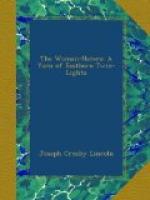MR. SETH ATKINS
The stars, like incandescent lights fed by a fast weakening dynamo, grew pale, faded, and, one by one, went out. The slate-colored sea, with its tumbling waves, changed color, becoming a light gray, then a faint blue, and, as the red sun rolled up over the edge of the eastern horizon, a brilliant sapphire, trimmed with a silver white on the shoals and along the beach at the foot of the bluff.
Seth Atkins, keeper of the Eastboro Twin-Lights, yawned, stretched, and glanced through the seaward windows of the octagon-shaped, glass-enclosed room at the top of the north tower, where he had spent the night just passed. Then he rose from his chair and extinguished the blaze in the great lantern beside him. Morning had come, the mists had rolled away, and the dots scattered along the horizon—schooners, tugs, and coal barges, for the most part—no longer needed the glare of Eastboro Twin-Lights to warn them against close proximity to the dangerous, shoal-bordered coast. Incidentally, it was no longer necessary for Mr. Atkins to remain on watch. He drew the curtains over the polished glass and brass of the lantern, yawned again, and descended the winding iron stairs to the door at the foot of the tower, opened it and emerged into the sandy yard.
Crossing this yard, before the small white house which the government provided as a dwelling place for its lightkeepers, he opened the door of the south tower, mounted the stairs there and repeated the extinguishing process with the other lantern. Before again descending to earth, however, he stepped out on the iron balcony surrounding the light chamber and looked about him.
The view, such as it was, was extensive. To the east the open sea, the wide Atlantic, rolling lazily in the morning light, a faint breeze rippling the surfaces of the ground-swell. A few sails in sight, far out. Not a sound except the hiss and splash of the surf, which, because of a week of calms and light winds, was low even for that time of year—early June.
To the north stretched the shores of the back of the Cape. High clay bluffs, rain-washed and wrinkled, sloping sharply to the white sand of the beach a hundred feet below. Only one building, except those connected with the lighthouses, near at hand, this a small, gray-shingled bungalow about two hundred yards away, separated from the lights by the narrow stream called Clam Creek—Seth always spoke of it as the “Crick”—which, turning in behind the long surf-beaten sandspit known, for some forgotten reason, as “Black Man’s Point,” continued to the salt-water pond which was named “The Cove.” A path led down from the lighthouses to a bend in the “Crick,” and there, on a small wharf, was a shanty where Seth kept his spare lobster and eel-pots, dory sails, nets, and the like. The dory itself, with the oars in her, was moored in the cove.




